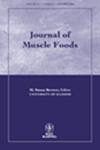In an attempt to improve the chemical, physical and sensory properties of beef burgers containing 11.5–13.7% fat, trials were carried out on eight experimental burger formulations containing carrageenan (0.5%), texturized soya (1.5%) and trisodium phosphate (0.5%), either alone or in different combinations, and compared with a control prepared only with the addition of salt and water. The data obtained were analyzed using a complete randomized design to study the effect of treatments on the proximate composition, thiobarbituric acid reactive substances (TBARS) value, percentage cooking loss, percentage diameter loss and sensory evaluation. The significant difference of the mean was determined using the least significant difference method. Although initial weight, cooked weight, initial diameter length and cooked diameter length were analyzed using means ± standard error. Analyses revealed unexpected interactions between some of the ingredients, the nature of which was not investigated. Results showed that the addition of carrageenan alone improved crude protein content, juiciness and overall acceptability of the beef burger, but it affected the appearance negatively, although there was no significant effect on diameter loss and thickness loss when compared with the control.
Beef burger prepared with the addition of texturized soya alone increased moisture binding and protein level, while it lowered flavor score compared with the control. With respect to the oxidative rancidity, TBARS value was found higher for the market sample; this value was significantly lower with the addition of combination of texturized soya and trisodium phosphate.
It has been found that the addition of a combination of carrageenan, texturized soya and trisodium phosphate reduced the cooking loss compared with the control, while there was no significant effect on the diameter loss and thickness loss of all treatments.
It was also found that the combination of carrageenan, texturized soya and trisodium phosphate improved all sensory attributes and improved protein contents compared with the control.
The sensory scores were highly correlated with each other. No significant correlations were found between moisture percentage and cooking loss together and sensory attributes, while there were high correlations between the TBARS and fat percentage with sensory attributes.
Reducing the fat content of beef burgers can make a significant contribution to human health and ensure the continuing popularity of this type of convenience food around the world. However, merely using leaner meat does not provide a product with the necessary quality attributes. So, practically, it has been found that the addition of carrageenan, texturized soya and trisodium phosphate can improve the beef burger sensory properties as a whole, including the appearance, color, flavor, tenderness, juiciness and overall acceptability. In addition, the oxidative rancidity (thiobarbituric acid reactive substances) of the product can also, be reduced. Above all, the quality of fat and its level has high correlation with the rancidity value and burger sensory attributes. Therefore, information is needed on suitable ingredient combinations that can maintain or enhance the quality of a low-fat version of the beef burger.


